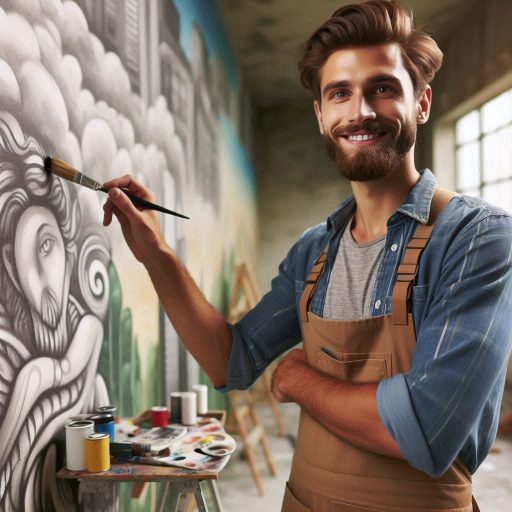Introduction
Mural art holds a significant place in American culture.
Murals are large-scale artworks painted directly onto walls or ceilings.
They often reflect social, political, and historical themes.
In America, murals have transformed public spaces into vibrant visual narratives.
From city buildings to schools, these artworks capture the essence of communities.
Murals in America date back to ancient indigenous cultures and have evolved over centuries.
In the early 20th century, the Mexican Muralist movement influenced American artists.
This period marked a renaissance in mural art, with artists seeking to make art accessible to the public.
Murals became a medium for storytelling and social commentary.
Muralists play a crucial role in the American art scene.
They bring art to everyday spaces, making it an integral part of public life.
Their work often reflects the cultural diversity and social issues of the time.
By integrating art into public spaces, muralists engage communities and foster dialogue.
Moreover, murals can revitalize neglected areas, transforming them into cultural hubs.
They attract visitors, boost local pride, and create a sense of identity.
Muralists also preserve historical moments and celebrate significant figures through their work.
In fact, mural art enriches American communities.
It provides a canvas for artistic expression and social commentary.
Muralists are essential in shaping the visual and cultural landscape of America.
Their contributions continue to influence and inspire both the art world and the public.
Transform Your Career Today
Unlock a personalized career strategy that drives real results. Get tailored advice and a roadmap designed just for you.
Start NowDiego Rivera: The Master of American Muralism
Background and Influence on American Muralism
Diego Rivera, a prominent Mexican artist, profoundly impacted American muralism.
Born in 1886 in Guanajuato, Mexico, Rivera trained in Europe before returning to Mexico.
His early exposure to Cubism and Italian Renaissance art shaped his style.
Rivera‘s murals, vibrant with political and social themes, influenced American artists during the Great Depression.
His work emphasized social justice and the power of collective action, resonating with the American mural movement’s goals.
Rivera‘s style combined bold colors and historical narratives, setting a new standard in mural art.
Iconic Works such as “Detroit Industry Murals”
Rivera’s “Detroit Industry Murals” are among his most celebrated works.
Completed between 1932 and 1933, these murals adorn the Detroit Institute of Arts.
The series features 27 panels illustrating industrial workers and machinery.
Rivera‘s attention to detail captures the essence of the American industrial age.
The murals highlight the labor force‘s role in industrial progress while celebrating the workers’ dignity.
The frescoes integrate Rivera‘s interest in combining art with social commentary, presenting a dynamic portrayal of industrial life.
Rivera’s Legacy in American Art
Diego Rivera’s influence extends beyond his murals.
His approach to public art challenged traditional aesthetics and inspired future generations.
Rivera‘s emphasis on integrating art with social and political themes left a lasting impact.
His murals continue to be a powerful reminder of art‘s ability to reflect and shape society.
Rivera‘s legacy lives on through the continued relevance of his work and the inspiration he provides to contemporary muralists.
His vision of art as a vehicle for social change remains influential in American art today.
Rivera‘s contributions to American muralism underscore the transformative power of art in capturing and shaping historical and social narratives.
Read: Art and Design Professions: Career Growth and Salaries
Transform Your Career Today
Unlock a personalized career strategy that drives real results. Get tailored advice and a roadmap designed just for you.
Start NowGrant Wood: The Journey from Regionalism to Muralism
Grant Wood, a prominent American artist, began his career rooted in Regionalism.
This movement celebrated rural American life and landscapes.
His iconic painting, American Gothic, showcased his talent for capturing the essence of Midwestern America.
However, Wood’s artistic path evolved significantly during the 1930s.
Transition from Regionalism to Muralism
As the Great Depression unfolded, Wood shifted his focus from Regionalism to muralism.
He embraced mural painting as a way to reach a broader audience and address social issues.
Wood’s transition reflected his growing concern for depicting the broader American experience, beyond just rural themes.
His murals aimed to convey messages of unity and resilience during tough economic times.
Famous Mural: “Concentration Camp”
One of Wood’s most compelling works from this period is the mural titled Concentration Camp.
Painted for the Iowa State Penitentiary, it portrays the harsh realities faced by prisoners.
The mural presents a stark, thought-provoking image of confinement and struggle.
Wood used this artwork to bring attention to issues of justice and human rights, showcasing his ability to use art for social commentary.
Wood‘s Impact on American Art During the Great Depression
Wood’s shift to muralism had a significant impact on American art during the Great Depression.
His murals provided a platform for discussing social issues and reflecting the struggles of the era.
By integrating social themes into his work, Wood influenced other artists and contributed to the larger conversation about art’s role in society.
His efforts helped elevate muralism as a vital medium for public discourse and artistic expression during challenging times.
Read: How to Start a Career as a Professional Muralist

Jos‘ Clemente Orozco: Mexican Muralist Who Influenced American Artists
Jos‘ Clemente Orozco was a pivotal figure in the muralist movement.
His work transcended borders, impacting American artists profoundly.
Born in Mexico, Orozco’s vibrant style and powerful themes made waves beyond his homeland.
Transform Your Career Today
Unlock a personalized career strategy that drives real results. Get tailored advice and a roadmap designed just for you.
Start NowHis murals depicted social justice, revolution, and human struggle, resonating deeply with audiences worldwide.
Orozco’s influence is evident in the way American artists embraced his techniques and thematic elements.
Works Like “Prometheus” at Pomona College
One of Orozco‘s most notable works is “Prometheus,” located at Pomona College in California.
This mural, completed in 1931, illustrates the mythological figure Prometheus who defies Zeus to bring fire to humanity.
Orozco‘s portrayal of Prometheus is dramatic and intense, reflecting his signature style.
The mural‘s bold use of color and dynamic composition captures Prometheus‘s defiance and the transformative power of knowledge.
“Prometheus” remains a significant piece in American art, showcasing Orozco‘s ability to convey complex narratives through murals.
Orozco’s Contributions to American Muralism
Orozco‘s contributions to American muralism are significant and enduring.
He introduced American artists to a new dimension of mural art, characterized by its socio-political themes and dynamic aesthetics.
His emphasis on storytelling and human struggle inspired many American muralists to explore similar themes in their work.
Orozco‘s innovative techniques, such as his use of fresco and dramatic color contrasts, influenced the development of American mural art.
His legacy endures through the murals he created and the artists he inspired, leaving a lasting mark on American art history.
Read: Grants and Funding Opportunities for Sculptors
Thomas Hart Benton‘
Thomas Hart Benton was a prominent American muralist known for his vivid depictions of everyday American life in his murals.
He was a central figure in the Regionalist art movement that emerged in the 1930s.
Representing American life in murals‘
Benton’s murals often depicted scenes of rural America, industrial landscapes, and everyday people engaged in various activities.
His style was characterized by bold lines, dynamic compositions, and a strong sense of movement.
One of Benton’s most famous works is the mural series titled “America Today,” which he completed in 1930.
This series consists of ten panels that showcase different aspects of American life, including urbanization, technology, and social issues.
Notable works like “America Today”‘
The “America Today” mural series is considered a masterpiece of American mural art and is housed in the lobby of the Equitable Life Building in New York City.
Transform Your Career Today
Unlock a personalized career strategy that drives real results. Get tailored advice and a roadmap designed just for you.
Start NowThe panels are large in scale and capture the vibrancy and diversity of American society in the early 20th century.
Other notable works by Benton include murals at the Missouri State Capitol in Jefferson City, Missouri, and in the Harry S. Truman Presidential Library and Museum in Independence, Missouri.
His murals continue to be admired for their bold storytelling and rich cultural imagery.
Benton’s influence on future generations of muralists‘
Thomas Hart Benton had a significant impact on the development of American mural art and influenced many artists who came after him.
His emphasis on storytelling, regionalism, and social commentary inspired a new generation of muralists to explore themes of identity, community, and history.
Artists such as Jackson Pollock and Charles Banks Wilson were among those who studied under Benton and were influenced by his bold and expressive style.
Benton’s legacy as a muralist continues to be celebrated for its contributions to American art and culture.
Read: How to Exhibit Your Glass Art
Judy Baca
Contemporary American muralist
Judy Baca stands out as a prominent contemporary American muralist.
Her work transcends traditional boundaries and brings murals into modern discourse.
Baca‘s vibrant murals capture cultural narratives and address social issues.
Her style incorporates diverse artistic techniques and community voices.
Founding member of Social and Public Art Resource Center
As a founding member of the Social and Public Art Resource Center (SPARC), Baca has profoundly influenced mural arts.
SPARC, established in 1976, promotes public art that reflects and serves the community.
Under Baca’s leadership, SPARC has produced numerous influential projects.
The center advocates for artistic expression that engages local populations and addresses pressing social issues.
Baca’s impact on community-based mural projects
Baca’s impact on community-based mural projects is significant and far-reaching.
Her murals often serve as a canvas for community stories and social justice themes.
She empowers communities to create art that speaks to their experiences and challenges.
Baca’s work fosters dialogue and encourages collective action.
Transform Your Career Today
Unlock a personalized career strategy that drives real results. Get tailored advice and a roadmap designed just for you.
Start NowHer murals often transform public spaces into places of reflection and engagement.
By involving community members in the artistic process, she enhances the relevance and impact of her work.
Through her role at SPARC and her individual projects, Judy Baca has left an indelible mark on the field of muralism.
Her innovative approach bridges art and activism, creating murals that resonate with viewers and participants alike.
Baca‘s contributions highlight the power of art in shaping community identity and fostering social change.
Her legacy continues to inspire new generations of muralists and artists committed to community engagement.
Shepard Fairey
Street artist known for political murals
Shepard Fairey, a prominent street artist, is renowned for his politically charged murals.
His art often intersects with political activism, pushing boundaries and provoking thought.
Fairey gained fame through his distinct visual style, characterized by bold colors and graphic elements.
Iconic “Hope” poster for Obama’s presidential campaign
One of his most iconic works is the “Hope” poster from Barack Obama’s 2008 presidential campaign.
This image, featuring a stylized portrait of Obama, quickly became a symbol of hope and change.
The poster‘s powerful message resonated with millions, amplifying Fairey‘s influence in the political sphere.
Fairey’s role in bringing political activism to mural art
Fairey‘s murals often incorporate strong political statements.
He uses art as a platform to comment on social issues, aiming to inspire dialogue and action.
His work reflects his belief in art’s potential to effect change.
By blending street art with political commentary, Fairey has redefined the role of muralists in contemporary art.
His approach has paved the way for other artists to engage in political discourse through their work.
Fairey‘s impact extends beyond his murals, influencing how political themes are portrayed in public spaces.
His contributions have highlighted the growing intersection between art and activism, demonstrating the power of murals to address societal issues.
In summary, Shepard Fairey‘s work exemplifies how street art can serve as a powerful tool for political expression.
Transform Your Career Today
Unlock a personalized career strategy that drives real results. Get tailored advice and a roadmap designed just for you.
Start NowHis iconic “Hope” poster and other political murals underscore his role in bridging art and activism.
Through his work, Fairey continues to inspire both artists and activists alike, showing that murals can be a compelling form of political commentary.
Discover More: Tips for Successful Interactive Media Design
Conclusion‘
Famous American muralists such as Diego Rivera, Thomas Hart Benton, and Keith Haring have made significant contributions to the art world with their iconic works.
These artists have used their talent and creativity to depict important social issues and cultural themes.‘
The importance of public art in American society cannot be understated.
Murals have the power to beautify neighborhoods, foster community pride, and provoke thought and discussion.
They serve as a form of visual storytelling that can resonate with people from all walks of life.‘
It is important to recognize and appreciate the work of muralists, as they play a vital role in enriching our cultural landscape.
By supporting these artists, we can ensure that their valuable contributions continue to inspire and educate future generations.
Let us continue to celebrate and champion the art of muralists and the impact they have on our society.




